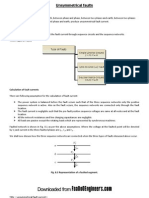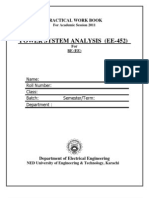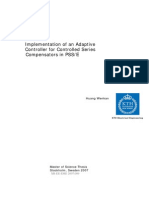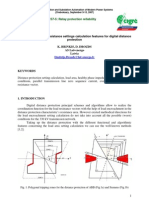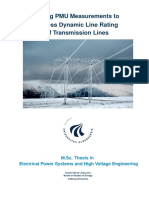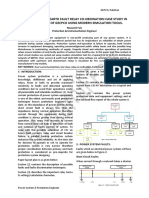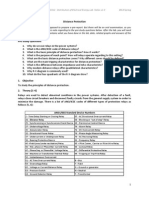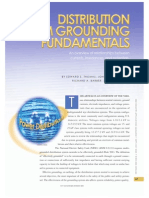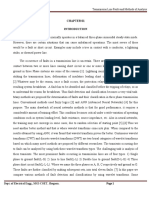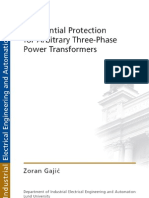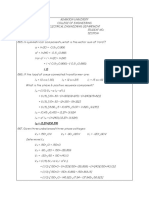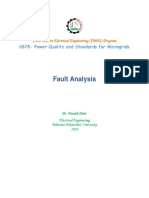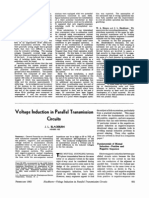Professional Documents
Culture Documents
Symmetrical Components
Uploaded by
Alcibiades MaytaOriginal Title
Copyright
Available Formats
Share this document
Did you find this document useful?
Is this content inappropriate?
Report this DocumentCopyright:
Available Formats
Symmetrical Components
Uploaded by
Alcibiades MaytaCopyright:
Available Formats
Symmetrical Components
Symmetrical Component Analysis
Synthesis of Unsymmetrical
Phases from Their Symmetrical
Components
The Symmetrical Components of
Unsymmetrical Phasors
Phase Shift of Symmetrical
Components in Y or Y
Transformer Banks
Power in Terms of Symmetrical
Components
Symmetrical Components
Unsymmetrical Series
Impedance
Sequence Impedance and
Sequence Network
Sequence Networks of
Unloaded generators
Sequence Network
Zero-Sequence Network
Symmetrical Component Analysis
Goal :
Symmetrical component analysis is a very useful tool
for dealing with unbalanced three-phase faults.
Synthesis of Unsymmetrical Phases from
Their Symmetrical Components
1
An unbalanced system of n related phasors can be resolved into
n systems of balanced phasors called the symmetrical components
of the original phasors. The n phasors of each set of components
are equal in lengths , and the angles between adjacent phasors of
the set are equal.
by C.L Fortescue , 1918
Synthesis of Unsymmetrical Phases from
Their Symmetrical Components
2
(1) Positive- sequence components
a1
b1
c1
(2) Negative-sequence components
c2
a2
b2
1. For positive- sequence
2. For negative-sequence
components
components
Synthesis of Unsymmetrical Phases from
Their Symmetrical Components
3
(3) Zero-sequence components
Va 0
Vb 0
Vc 0
0 For zero-sequence components
Synthesis of Unsymmetrical Phases from
Their Symmetrical Components
4
Va
Va 0
Va Va1 Va 2 Va 0
Va 2
Vc 2
Vc1
Vc 0
Vc
Vb
Vb 0
Va 1
Vb 2
Vb1
Vb Vb1 Vb 2 Vb 0
Vc Vc1 Vc 2 Vc 0
Synthesis of Unsymmetrical Phases from
Their Symmetrical Components
5
Use a to designate the operator that causes a rotation of 1200 in the
counterclockwise direction ,
a
a2
a 11200 0.5 j 0.866
a 1240 0.5 j 0.866
2
1, a 3
1, a 3
a 3 13600 1
a2
The Symmetrical Components of
Unsymmetrical Phasors
1
Vb1 a 2Va1 , Vc1 aVa1
Vb 2 a Va 2 , Vc 2 a 2Va 2
Vb 0 Va 0 , Vc 0 Va 0
c2
b1
a1
c1
a2
b2
The Symmetrical Components of
Unsymmetrical Phasors
2
Va Va1 Va 2 Va 0
Vb Vb1 Vb 2 Vb 0 a 2Va1 aVa 2 Va 0
Vc Vc1 Vc 2 Vc 0 a Va1 a 2Va 2 Va 0
Va 1
V 1
b
Vc 1
1
a2
a
1 Va 0
a Va1
a 2 Va 2
The Symmetrical Components of
Unsymmetrical Phasors
3
1
A 1
1
Va 0
1
V 1 1
a1 3
Va 2
1
1
a2
a
1
a
a2
1
a
a 2
A1
1
1
1
3
1
1
a
a2
1 Va
a 2 Vb
a Vc
* When three phase phasors are balanced , only the
positive-sequence component exists .
1
a 2
a
The Symmetrical Components of
Unsymmetrical Phasors
4
1.Sequence component representation of L-L voltage
Vab 0
1
V 1 1
ab1 3
Vab 2
1
1
a
a2
1 Vab
a 2 Vbc
a Vca
2.Sequence component representation of current
I a0
1
I 1 1
a1 3
I a 2
1
1
a
a2
1 I a
a 2 I b
a I c
The Symmetrical Components of
Unsymmetrical Phasors
5
1
(Va Vb Vc )
3
1
Vab 0 (Vab Vbc Vca )
3
1
I a0 (I a Ib Ic )
3
Va 0
No zero-sequence components exist if the sum of the three
phasors is zero.
The Symmetrical Components of
Unsymmetrical Phasors
6
Va 0
1
(Va Vb Vc )
3
Va 0 0
When 3 is balanced
Va 0 0
When
* If
(Va Vb Vc ) 0
Va 0 0 then 3 is unbalanced.
* Unbalanced
does not guarantee
Va 0 0 .
The Symmetrical Components of
Unsymmetrical Phasors
7
Vab 0
1
(Vab Vbc Vca )
3
Vab 0 is always zero
whether the three phase system
is balanced or not.
(Vab Vbc Vca ) is always zero (form closed loop)
b
a
c
The Symmetrical Components of
Unsymmetrical Phasors
8
Ia
1
I a0 (I a Ib Ic ) 0
3
Ib
( ungrounded Y )
Ic
Ia
Ib
Ic
Ia
Ib
Ic
In
1
I a0 (I a Ib Ic ) 0
3
( I a I b I c ) 3I a 0 I n
Y with a path to neutral
1
I a0 (I a Ib Ic ) 0
3
connected
VECTOR
SOFTWARE
The Symmetrical Components of
Unsymmetrical Phasors
9
One conductor of a three-phase line is open. The current flowing to the
example :
-connected load through line a is 10 A. With the current in line a as
reference and assuming that line c is open, find the symmetrical components
of the line currents
I a 100 0 amp
The line currents are :
I b 10180 amp
0
b
c
I a 100 0 A
I b 10180 0 A
Ic 0 A
Z
Ic 0
The Symmetrical Components of
Unsymmetrical Phasors
10
I a0
1
(1000 101800 0) 0 Since there no neutral current involved , I a 0
3
should be zero .
1
(1000 101800 1200 0)
3
5 j 2.89 5.78 30 0 A
1
(1000 101800 2400 0)
3
I a1
I a2
5 j 2.89 5.78 30 0 A
I b1 5.78 150 0 A
I c1 5.78 90 0 A
I b 2 5.78 150 0 A
I c 2 5.78 90 0 A
I b0 0
I c0 0
Phase Shift of Symmetrical Components
in Y or Y Transformers Banks
1
The American standard for designating terminal H1 and X 1 on Y or Y
transformer requires that the positive-sequence voltage drop from H1 to
neutral leads the positive-sequence voltage drop from X 1 to neutral by 300 ,
regardless of whether the Y or winding is on the high tension side .
Similarly, the positive-sequence voltage drop from H 2 to neutral leads the
voltage drop from X 2 to neutral by
300
and the positive-sequence voltage
drop from H 3 to neutral leads the voltage drop from X 3 to
neutral by
300
Phase Shift of Symmetrical Components
in Y or Y Transformers Banks
2
Example :
H1
X1
H1
X1
H2
X2
H3
B
C
H2
X2
X3
H3
X3
VA1 leads Vb1 by 300
VA1 leads Va1 by 300
Phase Shift of Symmetrical Components
in Y or Y Transformers Banks
3
The American standard for designating terminal H1 and X 1 on Y or Y
transformer requires that the negative-sequence voltage drop from H1 to
neutral lags the negative-sequence voltage drop from X 1 to neutral by 300 ,
regardless of whether the Y or winding is on the high tension side .
Similarly, the negative-sequence voltage drop from H 2 to neutral lags
the voltage drop from X 2 to neutral by 300 and the negative-sequence
voltage drop from H 3 to neutral lags the voltage drop from X 3 to neutral
by
300
Phase Shift of Symmetrical Components
in Y or Y Transformers Banks
4
Example :
H1
X1
H1
X1
H2
X2
H3
B
C
H2
X2
X3
H3
X3
(a)
VA2 lags Vb 2 by 30
(b) VA2 lags Va 2 by 30
Phase Shift of Symmetrical Components
in Y or Y Transformers Banks
5
A
H1
X1
H2
H3
X2
X3
Y
B1
b1
c1
Va1 leads VA1 by 900
A1
C1
VA1 leads Vb1 by 30
a2
C2
A2
a1
Va 2 lags VA2 by 900
b2
B2
c2
VA2 lags Vb 2 by 300
Phase Shift of Symmetrical Components
in Y or Y Transformers Banks
6
Example 11.7. The resistive Y-connected load bank of Example 11.2 is supplied from the low-voltage
Y-side of a Y- transformer. The voltages at the load are the same as in that example. Find the line
voltages and currents in per unit on the high-voltage side of the transformer.
I (1) a 0.9857 43 .60 per unit
I ( 2 ) a 0.2346 250 .30 per unit
V (1) an 0.985743.60 per unit(line to neutral voltage base)
V ( 2 ) an 0.2346 250 .30 per unit(line to neutral voltage base)
V (1) A 0.9857 43 .60 30 0 0.9857 73 .60 0.2785 j 0.9456
V ( 2 ) A 0.2346 250 .30 30 0 0.2346 220 .30 0.1789 j 0.1517
VA V (1) A V ( 2 ) A 0.0994 j 0.7939 0.882 .80 per unit
V (1) B a 2V (1) A 0.9857 46 .40 0.6798 j 0.7138
Phase Shift of Symmetrical Components
in Y or Y Transformers Banks
7
V ( 2 ) B a 2V ( 2 ) A 0.2346 19 .70 0.2209 j 0.0791
VB V (1) B V ( 2 ) B 0.9007 j 0.7929 1.20 41 .40 per unit
V (1)C a 2V (1) A 0.9857 193 .60 0.9581 j 0.2318
V ( 2 )C a 2V ( 2 ) A 0.2346 100 .30 0.0419 j 0.2318
VC V (1) C V ( 2 )C 1.0 j 0 1.0180 0 per unit
VAB VA V B 0.0994 j 0.7939 0.9007 j 0.7929 0.8013 j1.5868
1.78 116 .80 per unit(line neutral voltagae base)
1.78
116 .80 per unit(line to line voltagae base)
3
Phase Shift of Symmetrical Components
in Y or Y Transformers Banks
8
VBC VB V C 0.9007 j 0.7939 1.0 1.9007 j 0.7939
2.06 22 .70 per unit(line neutral voltagae base)
2.06
22 .70 1.19 22 .70 per unit(line to line voltagae base)
3
VCA VC V A 1.0 0.0994 j 0.7939 1.0994 j 0.97939
1.356 215 .80 per unit(line neutral voltagae base)
1.356
215 .80 0.783 215 .80 per unit(line to line voltagae base)
3
I A 0.80 82 .80 per unit
I B 1.20 41 .40 per unit
I C 1.0180 0 per unit
Phase Shift of Symmetrical Components
in Y or Y Transformers Banks
9
H1
X1
H1
X1
H2
X2
H3
B
C
H2
X2
X3
H3
X3
(a)
(1)
V (1) A leads V a
by 300
(b) V (1) A leads V (1) a by 300
Figure 11.23
labeling of lines connected to a three-phase Y- transformer.
Power in terms of Symmetrical Components
S P jQ Va I * a Vb I *b Vc I * c
Va
S Vb
Vc
Ia
*
I AV T AI
012
012
b
Ic
V012 AT A* I 012 3V012 I 012
T
3Va 0
Va1
I a0
Va 2
I
a
1
I a2
3(Va 0 I * a 0 Va1 I * a1 Va 2 I * a 2 )
, AT A* 3I
Unsymmetrical Series Impedance 1
a
Za
Ia
b
c
Ib
Zb
a'
Z ab
Z ca
Z c Z ac
Ic
Vaa '
Vbb '
V '
cc
Za
ba
Z ca
Z ab
Zb
Z cb
b'
c'
Z ac I a
I
Z bc
b
Zc
Ic
Unsymmetrical Series Impedance 2
Vaa ' 0 Z a
AVbb' 1 Z ba
V ' Z ca
cc 2
Z ab
Vaa ' 0
Za
1
V
A
Z
bb ' 1
ba
V '
Z ca
cc 2
Z ab
Zb
Z cb
Zb
Z cb
Z ac I a 0
Z bc A I a1
Z c I a 2
Z ac I a 0
Z bc A I a1
Z c I a 2
Unsymmetrical Series Impedance 3
Z 012 A1ZA
( Z s 0 2 Z M 0 )
( Z s1 2 Z M 1 )
( Z s 2 2 Z M 2 )
( Z s 2 2Z M 2 )
( Z s 0 2Z M 0 )
( Z s1 2 Z M 1 )
( Z s1 2 Z M 1 )
( Z s 2 2 Z M 2 )
( Z s 0 2 Z M 0 )
Where
1
Z s0 (Z a Zb Z c )
3
1
Z s1 ( Z a aZ b a 2 Z c )
3
1
Z s 2 ( Z a a 2 Z b aZ c )
3
1
( Z bc Z ca Z ab )
3
1
Z M 1 ( Z bc aZ ca a 2 Z ab )
3
1
Z M 2 ( Z bc a 2 Z ca aZ ab )
3
ZM 0
Unsymmetrical Series Impedance 4
Vaa ' 0 ( Z s 0 2 Z M 0 ) I a 0 ( Z s 2 2 Z M 2 ) I a1 ( Z s1 2 Z M 1 ) I a 2
Vaa ' 1 ( Z s1 2 Z M 1 ) I a 0 ( Z s 0 2 Z M 0 ) I a1 ( Z s 2 2 Z M 2 ) I a 2
Vaa ' 2 ( Z s 2 2 Z M 2 ) I a 0 ( Z s1 2 Z M 1 ) I a1 ( Z s 0 2 Z M 0 ) I a 2
Unsymmetrical Series Impedance 5
Case 1. If no coupling , Z ij ( i j ) 0
then
ZM 0 ZM1 ZM 2 0
Vaa ' 0 Z s 0 I a 0 Z s 2 I a1 Z s1 I a 2
1
1
1
I a 0 (Z a Z b Z c ) I a1 (Z a a 2 Z b aZc ) I a 2 (Z a aZb a 2 Z c )
3
3
3
Vaa ' 1 Z s1 I a 0 Z s 0 I a1 Z s 2 I a 2
1
1
1
I a 0 ( Z a aZb a 2 Z c ) I a1 ( Z a Z b Z c ) I a 2 ( Z a a 2 Z b Z c )
3
3
3
Vaa ' 2 Z s 2 I a 0 Z s1 I a1 Z s 0 I a 2
1
1
1
I a 0 ( Z a a 2 Z b aZc ) I a1 ( Z a aZb a 2 Z c ) I a 2 ( Z a Z b Z c )
3
3
3
Unsymmetrical Series Impedance 6
Case 2 . If
1.
Z a Zb Zc
2.
Z ij ( i j ) 0
Vaa ' 1 I a1 Z a
Complete transportation assumed
Vaa ' 2 I a 2 Z a
Vaa ' 0 I a 0 Z a
Symmetrical components of unbalanced currents flowing in a balanced-
load
or in balanced series impedances produce voltage drops of the same sequence ,
provided no coupling exists between phases.
If the impedances are unequal, the voltage drop of any one sequence is dependent on the
current of all three sequences.
If coupling such as mutual inductance exists among the three impedances, then the
formula will become more complicated.
Unsymmetrical Series Impedance 7
Assume:
1. No coupling
2.
Z a Zb Zc
Positive-sequence currents produce positive-sequence voltage drops.
Negative-sequence currents produce negative sequence voltage drops.
zero-sequence currents produce zero-sequence voltage drops.
Sequence Impedance and Sequence Network 1
The impedance of circuit when positive- sequence
current alone are flowing is called positive-sequence
impedance.
The impedance of circuit when negative-sequence
currents alone are flowing is called negative
sequence impedance.
When only zero-sequence currents are present, the
impedance is called zero sequence impedance.
Sequence Impedance and Sequence Network 2
The single-phase equivalent circuit composed of the impedance to
current of any one sequence only is called the sequence network.
Positive-sequence network contains positive sequence current and
positive sequence impedance only.
Negative-sequence network contains negative sequence current
and negative sequence impedance only.
Sequence Impedance and Sequence Network 3
Zero-sequence network contains zero sequence current and
zero sequence impedance only.
Sequence network carrying the individual currents
and I a 0 are interconnected to represent various
unbalanced fault condition.
I a1 , I a 2
Sequence Impedance and Sequence Network 4
Sequence Impedance of Various Devices
Positive
Negative
Zero
Line
same
same
different
Transformer
same
same
same
Machine
different *
different *
different
* Usually they are assumed to be the same
Sequence Networks of Unloaded Generators 1
a
Ia
Zn
In
- +
Ec
The generator voltage ( Ea , Eb , Ec )
Ea
are of positive sequence only,
Eb
+
since the generator is designed
to supply balanced three-phase
Ib
Ic
voltage.
Sequence Networks of Unloaded Generators 2
a
Reference
I a1
- Ea
- - Eb
+ Ec +
Z1
Z1
Ea
Z1
Va1 Ea I a1 Z1
Va 1
Z1
I b1
I a1
Ia
Positive-sequence
network
Reference
Z2
Z2
c
Z2
Ia2
Ib2
b I
c2
Va 2 I a 2 Z 2
Va 2
Z2
Ia2
Negative-sequence
network
Sequence Networks of Unloaded Generators 3
I c1
Zn
3I a 0
Z g0
Z g0
I a0
Z g0
c
Reference
I a0
3Z n
Z g0
I a0
Zero-sequence
network
Z n only appears in the zero-sequence
network
I a 0 ( Z g 0 3Z n )
Va 0
Z0
b I
a0
Va 0 I a 0 Z 0
3I a 0 I n
Sequence Networks of Unloaded Generators 4
Example 11.6. A salient-pole generator without dampers is rated 20 MVA, 13.8kV and has a
direct=axis subtransient reactance of 0.25 per unit. The negative-and-zero-sequence reactance
are, respectively, 0.35 and 0.10 per unit. The neutral of the generator is solidly grounded. With
0
the generator operating unloaded at rated voltage with Ean 1.00 per unit , a single line-to-
ground fault occurs at the machine terminals, which then have per-unit voltages to ground,
Va 0
Vc 1.013 102 .25 0
Vb 1.013 102 .25 0
Determine the subtransient current in the generator and the line-t0-line voltages for subtransient
conditions due to the fault.
a
Ia
Zn
Ia In
- n
- + Ecn
Ean
Figure 11.15
Ebn
+
b
Ib 0
Ic 0
Sequence Networks of Unloaded Generators 5
Figure 11.15 shows the line-to-ground fault of phase a of the machine.
Vb 0.215 j 0.990 per unit
Vc 0.215 j 0.990 per unit
Va ( 0)
1 1
( 0) 1
Vb 3 1 a
V ( 0)
1 a 2
c
( 0)
1
0
0.143 j 0
a 2 0.215 j 0.990 0.643 j 0 per unit
a 0.215 j 0.990 0.500 j 0
V ( 0) a
( 0.143 j 0)
j1.43 per unit
Z go
j 0.10
Sequence Networks of Unloaded Generators 6
(1)
( 2)
Ean V (1) a
(1.0 j 0) (0.643 j 0)
j1.43 per unit
Z1
j 0.25
V ( 2)a
( 0.500 j 0)
j1.43 per unit
Z2
j 0.35
There, the fault current into the ground is
I a I ( 0 ) a I (1) a I ( 2 ) a 3I ( 0 ) a j 4.29
The base current is 20 ,000 ( 3 13 .8) 837 A and so the subtransient current in line a is
I a j 4.29 837 j 3,590 A
Sequence Networks of Unloaded Generators 7
Line-to-line voltage during the fault are
Vab Va Vb 0.215 j 0.990 1.0177 .70 per unit
Vbc Vb Vc 0 j1.980 1.980 270 0 per unit
Vca Vc Va 0.215 j 0.990 1.0177 .70 per unit
Vab 1.01
13 .8
77 .70 8.0577 .70 kV
3
Vbc 1.980
Vca 1.01
13 .8
270 0 15 .78 270 0 kV
3
13 .8
102 .30 8.05102 .30 kV
3
Sequence Networks of Unloaded Generators 8
Before the fault the line voltages were balanced and equal to 13.8kV. For comparison with the line
voltages after the fault occurs, the prefault voltages, with Van Ean as reference, are given as
Vab 13 .830 0 kV
Vbc 13 .8270 0 kV
Vca 13 .8150 0 kV
Figure 11.6 shows phasor diagrams of prefault and postfault voltages.
b
Vab
a
Van
Vab
a
n
Vbc
Vca
Vbc
Vca
c
(a) Prefault
(b) Postfault
Figure 11.6
Sequence Networks of Unloaded Generators 9
The positive-sequence diagram of a generator is
composed of an emf in series with the positive-sequence
impedance of the generator.
The negative and zero-sequence diagrams contain no
emfs but include the negative and zero-sequence
impedances of the generator respectively.
Sequence Networks
The matching reactance in positive-sequence network is the subtransient ,transient,
or synchronous reactance, depending of whether subtransient , transient, or
steady- state condition are being studied.
The reference bus for the positive and negative sequence networks is the neutral
of the generator. So for as positive and negative sequence components are
concerned , the neutral of the generator is at ground potential even if these is Z n
connection between neutral and ground.
The reference bus for the zero sequence network is the ground (not necessary
the neutral of the generator).
Sequence Networks
Convert a positive sequence network to a negative sequence
network by changing, if necessary, only the impedance
that represent rotating machine , and by omitting the emf.
The normal one-line impedance diagram plus the induced emf is the
positive sequence network.
Three-phase generators and motors have internal voltage of positive
sequence only.
Example of Positive and Negative-Sequence Network 1
Example: Draw the positive and negative-sequence networks
for the system described as below . Assume that the
negative-sequence reactance of each machine is
equal to its subtransient reactance .Omit resistance.
T1
T
l
M1
n
r
M2
Example of Positive and Negative-Sequence Network 2
j 0.0815
j 0.0857
m
k
l
j 0.02
j 0.0915
n
j 0.2745
j 0.5490
+
Eg
E m1
(Positive)
Em 2
Reference bus
j 0.02
k
j 0.0857
j 0.5490
j 0.2745
p
l
j 0.0815
n
j 0.0915
(Negative)
Zero sequence Network
1 . Zero-sequence network currents will flow only if a return path exists.
2 . The reference bus of the zero-sequence network is the ground.
Reference
Zero sequence Network
R
Z
I n 3I a 0
Nn
3Z n
N
I a0
R
Z
Zero sequence Network
Zero-sequence equivalent circuit of three phase transform banks.
p
p
Zero-Sequence
Equivalent Circuit
Connection Diagrams
Symbols
Q
Z0
Reference bus
p
Q
Z0
Reference bus
Zero sequence Network
Symbols
4
Zero-Sequence
Equivalent Circuit
Connection Diagrams
p
Q
p
Z0
Reference bus
p
p
Q
p
Q
Z0
Reference bus
Zero sequence Network
Symbols
Zero-Sequence
Equivalent Circuit
Connection Diagrams
p
p
Z0
Reference bus
Zero sequence Network
Example:
Zn
3Z n
Q
Z g0
M
P
(Zero-Sequence)
Zero sequence Network
Q
Z g1
E g1
SEQUENCE
Zg2
NETWORK
E g1
SOFTWARE
(Positive-Sequence)
M
N
P
Q
S
(Negative-Sequence)
Zero sequence Network
Example 11.9. Draw the zero-sequence network for the system described in Example 6.1. Assume
zero-sequence network for the generator and motors of 0.05 per unit. A current-limiting reactor of
0.4
is in each of the each of the neutrals of the generator and the large motor. The zero-sequence
reactance of the transmission line is 1.5 km
Generator:
X 0 0.05 per unit
300 13.2 2
)(
) 0.0686 per unit
200 13.8
Motor 1:
X 0 0.05(
Motor 2:
X 0 0.05(
300 13.2 2
)(
) 0.1372 per unit
100 13.8
( 20 ) 2
Base Z
1.333
300
(13 .8) 2
Base Z
0.635
300
Zero sequence Network
3Z n 3(
0.4
) 0.900 per unit
1.333
3Z n 3(
Z0
0.4
) 1.890 per unit
0.635
1.5 64
0.5445 per unit
176.3
The zero-sequence network is shown in Fig. 11.28
k
j0.5445
j0.0857
j0.0915
n
j 0.05
j0.0686
j0.1372
j 0.900
j1.890
reference
You might also like
- Voltage ControlDocument25 pagesVoltage Controlbenson215100% (1)
- Assignment 2Document3 pagesAssignment 2Mashood NasirNo ratings yet
- VSC-FACTS-HVDC: Analysis, Modelling and Simulation in Power GridsFrom EverandVSC-FACTS-HVDC: Analysis, Modelling and Simulation in Power GridsNo ratings yet
- Symmetrical Fault AnalysisDocument13 pagesSymmetrical Fault AnalysisCh. Ali GhafoorNo ratings yet
- Symmetrical ComponentsDocument258 pagesSymmetrical ComponentsCaribNo ratings yet
- Over Current Protection AnnexDocument20 pagesOver Current Protection Annexryumadmax100% (1)
- Attachment Sphread Sheet For Differential Relay Setting of Transformers 87TDocument39 pagesAttachment Sphread Sheet For Differential Relay Setting of Transformers 87TMuhammad KahlilNo ratings yet
- Symmetrical ComponentsDocument6 pagesSymmetrical ComponentsezzateisNo ratings yet
- 9-Current TransformerDocument110 pages9-Current TransformermubarakkirkoNo ratings yet
- Symmetrical ComponentsDocument75 pagesSymmetrical Componentsrasim_m1146No ratings yet
- New Chapter 6 Symmetrical ComponentsDocument23 pagesNew Chapter 6 Symmetrical ComponentsOsman AhmedNo ratings yet
- Unsymmetrical FaultsDocument16 pagesUnsymmetrical FaultsBhairab BoseNo ratings yet
- EMTP SimulDocument14 pagesEMTP SimulkjfenNo ratings yet
- Symmetrical Componet Fauly CalculationDocument522 pagesSymmetrical Componet Fauly CalculationsreedharNo ratings yet
- Distance Protection - Eercise 1 - MemoDocument7 pagesDistance Protection - Eercise 1 - Memomoses kakwenaNo ratings yet
- Testing Directional Overcurrent ProtectionDocument2 pagesTesting Directional Overcurrent ProtectionZokiNo ratings yet
- EE-452 - Power System Analysis - 2011Document44 pagesEE-452 - Power System Analysis - 2011eaf1No ratings yet
- Load Flow Analysis PDFDocument33 pagesLoad Flow Analysis PDFRakshitha VNo ratings yet
- Transfomer ProtectionDocument56 pagesTransfomer Protectionengkos koswaraNo ratings yet
- What Is Arcing Ground PhenomenaDocument3 pagesWhat Is Arcing Ground PhenomenaAbhisht YadavNo ratings yet
- Proposal Setting Gi Tanjung BungaDocument20 pagesProposal Setting Gi Tanjung Bungawandy RJ100% (1)
- TechRef 3-W-Transformer 3phaseDocument40 pagesTechRef 3-W-Transformer 3phaseTorrez JeanNo ratings yet
- L4-Power Flow AnalysisDocument42 pagesL4-Power Flow AnalysisHarinidevi NadarajanNo ratings yet
- 6837X 12bDocument42 pages6837X 12bJorge A. Perez YebraNo ratings yet
- K-Factor Measurement of CablesDocument4 pagesK-Factor Measurement of CablesAhmed HamzehNo ratings yet
- IDMT Coordination ExampleDocument5 pagesIDMT Coordination ExampleJai GuptaNo ratings yet
- Study of Short Circuit Faults-Case Study Sudanese National GridDocument75 pagesStudy of Short Circuit Faults-Case Study Sudanese National GridYousra Daya0% (1)
- Protection and Switchgear - by BakshiDocument397 pagesProtection and Switchgear - by BakshiAhmed Elaraby50% (2)
- Calculation of IBIAS in RET670 For Yd1 Transformer Ver2Document8 pagesCalculation of IBIAS in RET670 For Yd1 Transformer Ver2rohitctppNo ratings yet
- Sequence Impedance in Different Power EquipmentsDocument7 pagesSequence Impedance in Different Power EquipmentsMadhusudhan Srinivasan0% (1)
- Tesis FLECS PSSEDocument79 pagesTesis FLECS PSSEgabiiteamoNo ratings yet
- Traveling WaveDocument59 pagesTraveling WaveMohit Kumar ChowdaryNo ratings yet
- One Case Study-Practical Protection Engineering BasicDocument4 pagesOne Case Study-Practical Protection Engineering BasicarsalanhamidNo ratings yet
- Power System Analysis Lab 5Document13 pagesPower System Analysis Lab 5divanteNo ratings yet
- Load Encroachment Resistance Settings Calculation Features For Digital Distance Protection K. Brinkis, D. Drozds AS Latvenergo LatviaDocument6 pagesLoad Encroachment Resistance Settings Calculation Features For Digital Distance Protection K. Brinkis, D. Drozds AS Latvenergo LatviasajedarefinNo ratings yet
- 3 Winding Transformer Commissioning TestDocument5 pages3 Winding Transformer Commissioning TestRagab TolbaNo ratings yet
- CIRED2015 0448 Final PDFDocument5 pagesCIRED2015 0448 Final PDFRolando Henry Flores CamavilcaNo ratings yet
- 1MRG009710 en Application Note Overall Differential Protection For Thermal Power PlantDocument9 pages1MRG009710 en Application Note Overall Differential Protection For Thermal Power Plantbdiaconu20048672No ratings yet
- EE5220 Project TRV CBRatings ReportDocument22 pagesEE5220 Project TRV CBRatings ReportsasikalasivakumarNo ratings yet
- Representation of Power System Components 2 and FaultsDocument57 pagesRepresentation of Power System Components 2 and FaultsWanki E Phawa SungohNo ratings yet
- Calculating Sequence Impedances of Transmission Line Using Pmu MeasurementsDocument112 pagesCalculating Sequence Impedances of Transmission Line Using Pmu MeasurementsLucas Marinho100% (1)
- Relay Coordination Calculations and Time Current CurvesDocument7 pagesRelay Coordination Calculations and Time Current CurvesFareh KhanNo ratings yet
- Ref Abb Ret670Document4 pagesRef Abb Ret670ZokiNo ratings yet
- ANGEN - EN006 Current Transformer Selection For VAMP Series Overcurrent and Differential Relays PDFDocument8 pagesANGEN - EN006 Current Transformer Selection For VAMP Series Overcurrent and Differential Relays PDFRicardo BozoNo ratings yet
- Template Version 20181231: Equipment Detail ( ) - Input Details: Low Impedance Differential ProtectionDocument6 pagesTemplate Version 20181231: Equipment Detail ( ) - Input Details: Low Impedance Differential ProtectionGirija Sankar PatiNo ratings yet
- NERC Protection System Protection Fundamentals Public 060210Document55 pagesNERC Protection System Protection Fundamentals Public 060210srinivasaphanikiranNo ratings yet
- Calculation For CT SelectionDocument18 pagesCalculation For CT Selectionmithun46100% (2)
- Paper On Automatic Reclosing Transmission Lines Applications and Its ConsiderationsDocument8 pagesPaper On Automatic Reclosing Transmission Lines Applications and Its ConsiderationsGagan GillNo ratings yet
- Overcurrent Protection For Phase and Earth FaultsDocument30 pagesOvercurrent Protection For Phase and Earth Faultshossein2012100% (1)
- CT Saturation PDFDocument16 pagesCT Saturation PDFsureshNo ratings yet
- How To Size Current TransformersDocument3 pagesHow To Size Current TransformersVasu IyerNo ratings yet
- Web - Itu.edu - TR Yumakk Downloads Lab Notes Distance Protection v1Document6 pagesWeb - Itu.edu - TR Yumakk Downloads Lab Notes Distance Protection v1sunitharajababuNo ratings yet
- Capacitor Bank ProtectionDocument17 pagesCapacitor Bank ProtectionskisakNo ratings yet
- Balanced Three-Phase CircuitsDocument40 pagesBalanced Three-Phase CircuitsralucaNo ratings yet
- Symmetrical Components PDFDocument21 pagesSymmetrical Components PDFAhmed Fawad AnsariNo ratings yet
- B 31290735Document75 pagesB 31290735chibssa alemayehuNo ratings yet
- EEE. 2mark and 16 Marks Quest-With AnswerDocument21 pagesEEE. 2mark and 16 Marks Quest-With AnswerPrasanth Govindaraj100% (1)
- Three-Phase Power Flow Analysis in Sequence Component FrameDocument19 pagesThree-Phase Power Flow Analysis in Sequence Component FramebbcrNo ratings yet
- Easy Method For Testing Transformer Differential RelaysDocument12 pagesEasy Method For Testing Transformer Differential Relaysntayyebi100% (1)
- Short Circuit StudyDocument29 pagesShort Circuit StudyPramod B.Wankhade100% (3)
- Perun ItDocument32 pagesPerun ItAlcibiades MaytaNo ratings yet
- Short Circuit CalculationDocument46 pagesShort Circuit Calculationratnesh_xp1No ratings yet
- There Phase FaultDocument32 pagesThere Phase FaultAlcibiades Mayta100% (1)
- Distribution Systems Grounding FundamentalsDocument10 pagesDistribution Systems Grounding FundamentalsAlcibiades MaytaNo ratings yet
- Cutler Hammer Spec SheetDocument30 pagesCutler Hammer Spec SheetAlcibiades MaytaNo ratings yet
- Ee6711 PSS Lab Viva QuestionsDocument10 pagesEe6711 PSS Lab Viva QuestionsshreeNo ratings yet
- Symmetrical ComponentDocument27 pagesSymmetrical ComponentTahir KedirNo ratings yet
- Allen Bradley Power Monitor 3000 Manual PDFDocument356 pagesAllen Bradley Power Monitor 3000 Manual PDFAndrewcaesar100% (1)
- Lab WorkDocument22 pagesLab WorkTamil SelvanNo ratings yet
- Transmission Line Faults and Methods of Analysis: Dept. of Electrical Engg., MGI-COET, ShegaonDocument28 pagesTransmission Line Faults and Methods of Analysis: Dept. of Electrical Engg., MGI-COET, ShegaonAvinash ChimkarNo ratings yet
- Diffentian Transformer ProtectionDocument227 pagesDiffentian Transformer ProtectionHuget St100% (3)
- Schedule of EEE-305Document3 pagesSchedule of EEE-305noybit mondalNo ratings yet
- Electrical Power SystemsDocument526 pagesElectrical Power Systemspooja100% (1)
- CP1 B9 Lecture No. 4 - Short Circuit Analysis PDFDocument195 pagesCP1 B9 Lecture No. 4 - Short Circuit Analysis PDFHillNo ratings yet
- Symmetrical Components & Faults CalculationsDocument26 pagesSymmetrical Components & Faults CalculationsRTNo ratings yet
- MDGF Protection Systems PresentationDocument77 pagesMDGF Protection Systems Presentationjobpei2100% (1)
- Pi Fortescue Equivalent Admittance Matrix Approach To Power Flow SolutionDocument10 pagesPi Fortescue Equivalent Admittance Matrix Approach To Power Flow SolutionMacobasNo ratings yet
- TP10 Fundamentals of Power System Modeling v2018-11-12 43rd ANC (FCLeynes)Document37 pagesTP10 Fundamentals of Power System Modeling v2018-11-12 43rd ANC (FCLeynes)Edwin LoquinaNo ratings yet
- Tutorial 7Document3 pagesTutorial 7Dhivya NNo ratings yet
- Fault Analysis: Kibrom GDocument37 pagesFault Analysis: Kibrom Gmillion100% (1)
- 23344434Document13 pages23344434jenixson tamondong0% (1)
- Induction Motors - Modelling and ControlDocument558 pagesInduction Motors - Modelling and ControlCesar CarácterNo ratings yet
- 5 Fault AnalysisDocument45 pages5 Fault AnalysisSari M.INo ratings yet
- Short Circuit Analysis Objective Type QuestionsDocument7 pagesShort Circuit Analysis Objective Type Questionsjiguparmar1516No ratings yet
- Effect of Arc Resistance of Line FaultsDocument6 pagesEffect of Arc Resistance of Line FaultsNilesh ThakreNo ratings yet
- 6018 ThreePhaseCircuit Web PDFDocument18 pages6018 ThreePhaseCircuit Web PDFquisi123No ratings yet
- Asymmetrical Fault Analysis On Distribution Feeders With Inverter InterfacedDocument10 pagesAsymmetrical Fault Analysis On Distribution Feeders With Inverter InterfacedAbcdNo ratings yet
- Voltage Induction in Parallel Transmission CircuitsDocument9 pagesVoltage Induction in Parallel Transmission CircuitsQM_2010No ratings yet
- Course Syllabus ECE 610 - Symmetrical Components: Department: Course Number: Course Title: Credit Hours: Contact HoursDocument2 pagesCourse Syllabus ECE 610 - Symmetrical Components: Department: Course Number: Course Title: Credit Hours: Contact Hoursldnladiesman217No ratings yet
- ABB ProtectionDocument356 pagesABB Protectionmohamedayazuddin100% (1)
- Unit 4Document5 pagesUnit 4Sri Ram KNo ratings yet
- OMICRON CPOL Polarity Checker DatasheetDocument64 pagesOMICRON CPOL Polarity Checker Datasheetkra_amNo ratings yet
- Phase Selection For 1 Pole Tripping Week Infeed Conditions Cross Country Faults Ger 3997Document22 pagesPhase Selection For 1 Pole Tripping Week Infeed Conditions Cross Country Faults Ger 3997Erick_Van32No ratings yet
- Ground Fault Protection Isolated NeutralDocument18 pagesGround Fault Protection Isolated Neutralriddler_007No ratings yet
- Identifying The Proper Impedance Plane and Fault Trajectories in Distance Protection AnalysisDocument14 pagesIdentifying The Proper Impedance Plane and Fault Trajectories in Distance Protection AnalysisVignesh ChalapathyNo ratings yet











